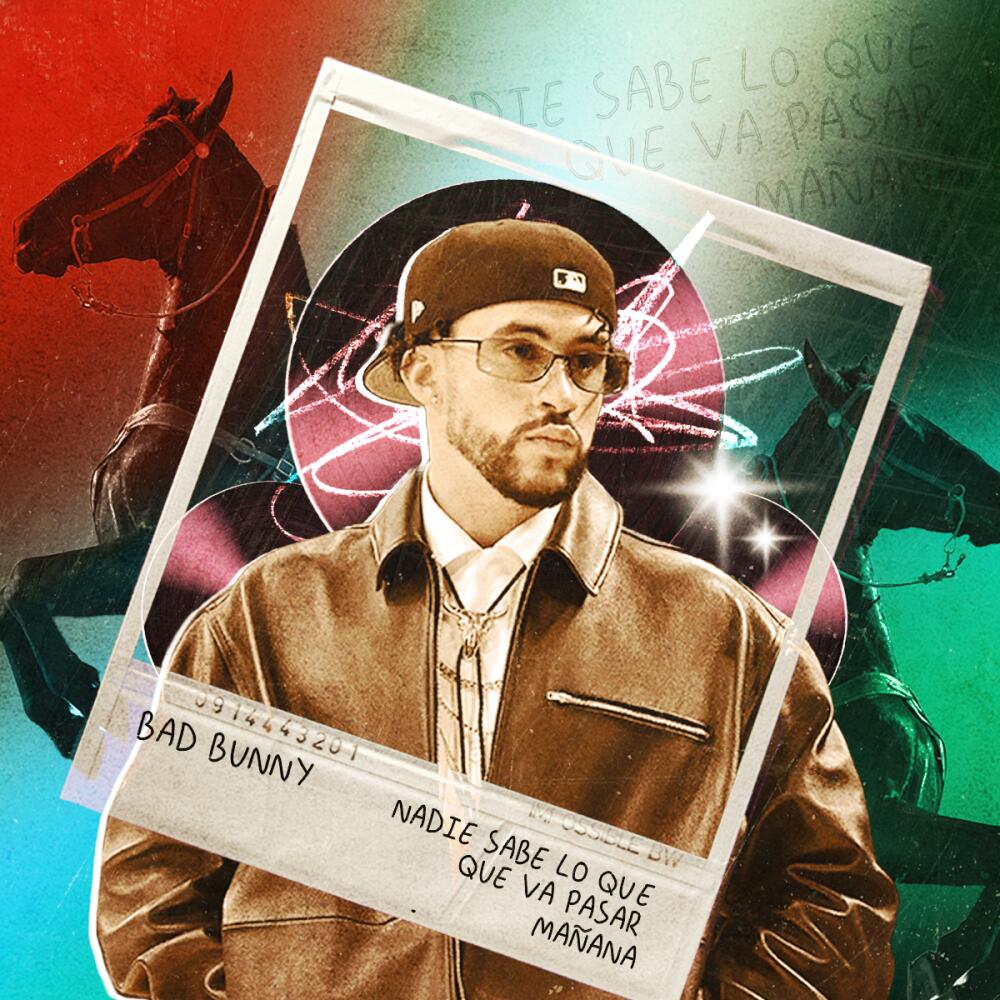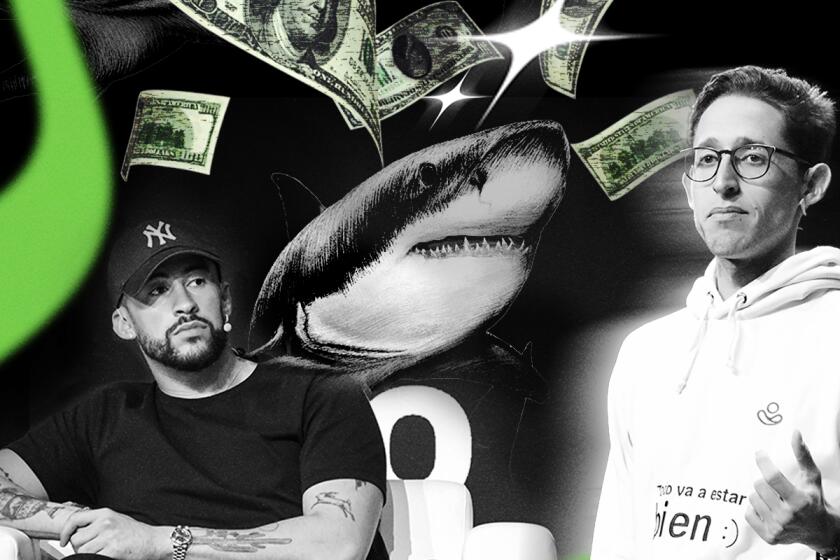
- Share via
By the onset of 1977, Héctor Lavoe, the Puerto Rican salsero of legend, was down and out. Lavoe, a Fania All Star who once soared in hit songs like “Mi Gente” and “Periódico de Ayer,” had been mollifying the burdens of his growing fame with narcotics — a habit that spiraled into addiction. Both his bandmates and audience, citing his erratic nature and increasing tardiness at concerts, began to turn on him.
Bad Bunny touched down in Cleveland, Ohio earlier this week for the Forbes Under 30 Summit, where he played the top judge of his own “Shark Tank”-inspired competition.
Bandleader Willie Colón, desperate to toss a life vest to the prized yet floundering singer, asked Panamanian singer-composer Rubén Blades to lend a song that could rescue Lavoe’s career. Thus came the thesis statement of Lavoe’s sardonically titled comeback album “Comedia”: the dark, confessional salsa piece “El Cantante,” in which Lavoe lamented the psychological cost of pop stardom.
Such is the spiritual root of “Nadie Sabe Lo Que Va a Pasar Mañana,” the fifth solo studio album by the Puerto Rican-gone-global superstar Bad Bunny, released on Friday, Oct. 13. Fresh off an extended break from social media, and now ears-deep in his Hollywood era, the 29-year-old pulls back the curtain and lets us into his head for 22 songs — strictly on his terms.
Bad Bunny’s straits are not nearly as dire as those of his long-departed hero Lavoe. After all, the Grammy-winning artist fulfilled his dream of becoming a millionaire before his 30th birthday; he moved to the Hills and appeared in movies alongside Brad Pitt and Gael García Bernal; and, to the outrage of his most loyal Latina fans, he’s been photographed on the arm of American reality TV princess Kendall Jenner.
Yet where Lavoe once rued the gilded cage of fame — “Nadie pregunta / Si sufro, si lloro / Si tengo una pena / Que hiere muy hondo,” he sang in 1978 — Bad Bunny adorns it with totems of his hard-earned life of luxury. With the Champagne-drenched braggadocio of songs like “Monaco,” it becomes apparent that trophies, cars and beautiful women serve as consolation prizes for what Bad Bunny lost in the privacy and intimacy that he once enjoyed as Benito. As he crows in the orchestral opening track, being as famous as he is means that he doesn’t have to answer to just anyone anymore; definitely not the fans who monitor his dating habits, nor the girl whose phone he notably flung away from his face back in January. “I’m not a trapper, nor a reggaetónero,” he reminds us all in Spanish. “I am the biggest star in the whole world.”

It’s an attitude shift that might have completely alienated Bad Bunny’s listeners, had he not revived the sound that endeared us all to him in the first place: Latin trap.
Benito, who first won hearts with early Soundcloud bangers like “Diles” and “Soy Peor,” teleported back to 2016 to add dimension to the full-circle moment he commemorates in “Nadie Sabe.” It’s with those hard-edged beats that one can more fully appreciate Bad Bunny — not just as the Latino heartthrob, nor the Puerto Rican resistance leader we got to know in previous eras, but as a rapper’s rapper. Each verse bounces nimbly after the other like loose change in “Los Pits,” and he rolls playfully with the effervescent synths in “No Me Quiero Casar,” offering a candid reflection on his marital status (or lack thereof).
And as always, he flaunts his Puerto Rican bona fides: For the six-minute scamp’s anthem “Acho PR,” he ushered in veteran MC Ñengo Flow and reunited the former duo Arcángel and De La Ghetto. Bad Bunny also paid it forward by welcoming in a formidable lineup of Boricuas on the rise, including Eladio Carrión, Young Miko, Mora, Bryant Myers, Yovngchimi and Luar La L. (The outlier is Colombian hitmaker Feid, who lends a touch of pop magic to the reggaetón track “Perro Negro.”)
Get the Latinx Files newsletter
Stories that capture the multitudes within the American Latinx community.
You may occasionally receive promotional content from the Los Angeles Times.
Young Miko, arguably the MVP in Bad Bunny’s illustrious guest list, takes the wheel on “Fina,” a frisky queer jam that exalts women who lean into their sexuality, whether society accepts it or not. (The sentiment gives a little more kick with a sample from Tego Calderón’s 2002 hit “Pa’ Que Retozen,” in which he claimed “las más putas son las más finas.”)
Bad Bunny captains a refreshing change of pace with Mora in the brisk house number “Hibiki,” followed by the MAG-produced Jersey club romps “Where She Goes” and “Cybertruck.” He then cools off with “Vou 787,” in which he says, “if I were a woman, I’d be Madonna, I’d be Rihanna.” (Madge’s 1990 anthem “Vogue” is delicately sampled.)
Yet Benito’s lyricism devolves into petulant Drakeism on “Baby Nueva,” a bitter parade of vitriol aimed at an ex he swears he doesn’t lose sleep over. (“Ya ni Mami te quiere,” he spits coldly, asserting to his antagonist that “not even Mommy loves you anymore.”) Even the unbridled hedonism described in “Teléfono Nuevo” couldn’t conceal the cursed feelings underpinning his vacuous sexcapades. “I look happy, but only in old photos,” Benito intimates in Spanish. “God hears me and says, ‘Wow, why does this f—er complain?’”
In “Nadie Sabe,” Bad Bunny proves that not even his peers in the music industry are safe from his ire. In the tradition of a tiraera, or a diss track, Bad Bunny seemingly takes a shot at Colombian pop star Karol G in “Vuelve Candy B,” in which he pokes fun at the reappropriation of the word “bichota” — which stems from “bichote,” a Puerto Rican slang term for a high-level drug dealer. He spits, “I’m from P.R., where the real ‘bichotas’ come from.”
Bad Bunny then made headlines Friday with a tiraera aimed at his “Oasis” collaborator J Balvin, in the Eladio Carrión-assisted drill track “Thunder y Lightning.” In what can be construed as a dig at Balvin’s readiness to concede authenticity for commercial gain, Bad Bunny raps in Spanish: “You’ve seen me with the same people while you are friends with the whole world like Balvin.”
(Balvin quizzically addressed the line on Instagram: “We supported each other mutually, we made history, we also created a new story within music… I don’t understand what was going through his head, but the guy I know is a good person.”)
Ultimately, the Bad Bunny we get to know in “Nadie Sabe” is a much-beloved superstar who has been hunkered down on the defensive too long — whether from critics, haters, alarmingly possessive fans, or other entities that have seemed to whittle away at his humanity. The cold, brutalist tower he’s built in “Nadie Sabe” stands in contrast to the wellspring of rich, modern-day Puerto Rican storytelling that we drank from in previous albums.
We may never have the privilege of knowing the real Bad Bunny, or the real Benito Antonio Martínez Ocasio; but we will miss him when he’s gone.
More to Read
The Latinx experience chronicled
Get the Latinx Files newsletter for stories that capture the multitudes within our communities.
You may occasionally receive promotional content from the Los Angeles Times.








